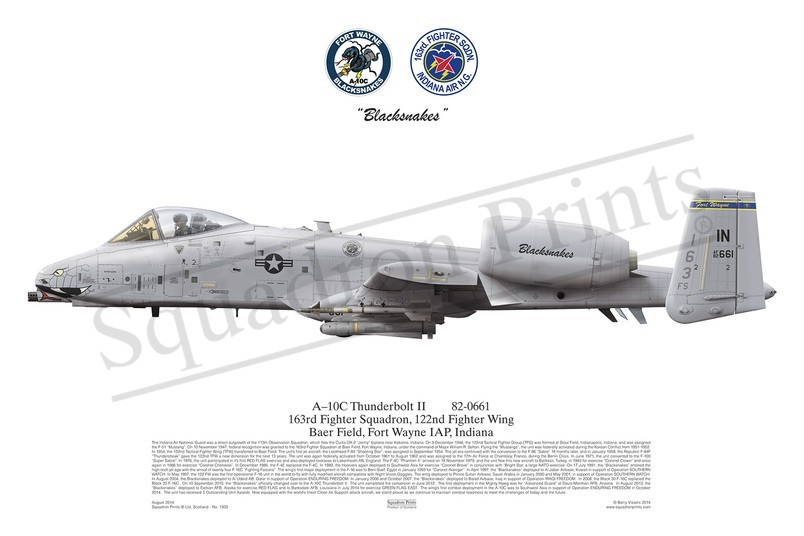#1303 A-10C Thunderbolt II

Purchased products will not feature the Squadron Prints watermark
Description
Squadron Prints Lithograph No. 1303 - A-10C Thunderbolt II, 82-0661, 163rd Fighter Squadron, 122nd Fighter Wing, Baer Field, Fort Wayne IAP, Indiana.
The Indiana Air National Guard was a direct outgrowth of the 113th Observation Squadron, which flew the Curtis OX-2 “Jenny” biplane near Kokomo, Indiana. On 9 December 1946, the 122nd Tactical Fighter Group (TFG) was formed at Stout Field, Indianapolis, Indiana, and was assigned the F-51 “Mustang”. On 10 November 1947, federal recognition was granted to the 163rd Fighter Squadron at Baer Field, Fort Wayne, Indiana, under the command of Major William R. Sefton. Flying the “Mustangs”, the unit was federally activated during the Korean Conflict from 1951-1952. In 1954, the 122nd Tactical Fighter Wing (TFW) transferred to Baer Field. The unit’s first jet aircraft, the Lockheed F-80 “Shooting Star”, was assigned in September 1954. The jet era continued with the conversion to the F-86 “Sabre” 18 months later, and in January 1958, the Republic F-84F “Thunderstreak” gave the 122nd TFW a new dimension for the next 13 years. The unit was again federally activated from October 1961 to August 1962 and was assigned to the 17th Air Force at Chambley, France, during the Berlin Crisis. In June 1971, the unit converted to the F-100 “Super Sabre”. In 1976, the unit participated in it’s first RED FLAG exercise and also deployed overseas to Lakenheath AB, England. The F-4C “Phantom II” arrived on 18 November 1979, and the unit flew this new aircraft to Balikesir, Turkey, in 1983 for exercise “Coronet Crown” and once again in 1986 for exercise “Coronet Cherokee”. In December 1986, the F-4E replaced the F-4C. In 1989, the Hoosiers again deployed to Southwest Asia for exercise “Coronet Brave” in conjunction with “Bright Star, a large NATO exercise. On 17 July 1991, the “Blacksnakes” entered the high-tech jet age with the arrival of twenty four F-16C “Fighting Falcons”. The wing’s first major deployment in the F-16 was to Beni-Suef, Egypt in January 1993 for “Coronet Avenger”. In April 1997, the “Blacksnakes” deployed to Al Jaber Airbase, Kuwait in support of Operation SOUTHERN WATCH. In May 1997, the 122 FW was the first operational F-16 unit in the world to fly with fully modified aircraft compatible with Night Vision Goggles. The wing deployed to Prince Sultan Airbase, Saudi Arabia in January 2000 and May 2001, in support of Operation SOUTHERN WATCH. In August 2004, the Blacksnakes deployed to Al Udeid AB, Qatar in support of Operation ENDURING FREEDOM. In January 2006 and October 2007, the “Blacksnakes” deployed to Balad Airbase, Iraq in support of Operation IRAQI FREEDOM. In 2008, the Block 30 F-16C replaced the Block 25 F-16C. On 10 September 2010, the “Blacksnakes” officially changed over to the A-10C Thunderbolt II. The unit completed the conversion in June 2012. The first deployment in the Mighty Hawg was for “Advanced Guard” at Davis-Monthan AFB, Arizona. In August 2013, the “Blacksnakes” deployed to Eielson AFB, Alaska for exercise RED FLAG and to Barksdale AFB, Louisiana in July 2014 for exercise GREEN FLAG EAST. The wing’s first combat deployment in the A-10C was to Southwest Asia in support of Operation ENDURING FREEDOM in October 2014. The unit has received 5 Outstanding Unit Awards. Now equipped with the world’s finest Close Air Support attack aircraft, we stand proud as we continue to maintain combat readiness to meet the challenges of today and the future.
You may also like
-
Puma, Apache, Chinook, Wildcat and Merlin Print
ZJ954; ZK550; ZJ122; ZH902; ZZ512; ZM70522 SqnRAF Benson; RNAS Yeovilton; Middle Wallop -
VMFA-115 F/A-18 Hornet print
165214 '01'; 164679 '22'VMFA-115MCAS Beaufort, South Carolina -
#2SQN68 Coin/KeyFob/Lanyard/Pin
SALE II(AC) Squadron Op Shader 2022 Opener Coin
2 SqnRAF Akrotiri; RAF Lossiemouth
